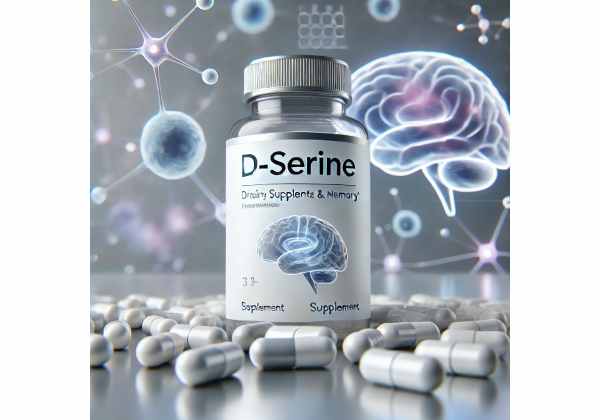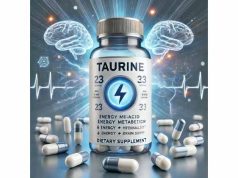
D-serine, a unique amino acid found naturally in the body, has attracted substantial attention for its potential in supporting mental balance, cognitive clarity, and various psychiatric therapies. Unlike many commonly known nutrients, D-serine directly influences neurotransmission systems crucial for learning, memory, and emotional stability. Emerging data suggests that supplementing with D-serine may bolster brain health, sharpen focus, and help mitigate symptoms related to certain mental disorders. From modulating key receptor pathways to aiding neuroplasticity, D-serine stands out as an intriguing contender for those eager to enhance cognitive performance and overall mental wellness. Read on to discover how D-serine could transform your approach to brain health.
Table of Contents
- Understanding D-Serine: A Look into Its Nature and Origins
- How D-Serine Elevates Brain Function and Mental Wellness
- Prominent Psychiatric and Cognitive Benefits of D-Serine
- Effective Strategies for Incorporating D-Serine into Your Routine
- Investigations and Clinical Trials on D-Serine
- Frequently Asked Questions about D-Serine
- References and Sources
Understanding D-Serine: A Look into Its Nature and Origins
D-serine is an enantiomer of the more commonly known L-serine. Both forms belong to the serine family of amino acids, but they differ subtly in their molecular orientation. This orientation difference is crucial for how each version interacts with receptors and enzymes within the human body. While the “L” form usually contributes to protein building, the “D” form is especially relevant for neurological processes, making it a compelling topic among mental health researchers.
A Rare Amino Acid with Powerful Potential
In biochemistry, D-amino acids were once considered anomalies, predominantly found in bacteria rather than in human tissues. However, scientific breakthroughs over the past few decades revealed that D-serine is not only present in the human body but also plays an integral role in the functioning of the central nervous system (CNS). Much of its significance stems from its involvement in modulating neurotransmitters and supporting plasticity, two pillars of robust cognitive function and emotional equilibrium.
D-Serine’s Natural Sources
Although most dietary proteins comprise L-amino acids, trace amounts of D-serine appear in certain fermented foods, such as fermented soybeans, cheeses, or yogurts. Nonetheless, these amounts are generally small. The human body can synthesize D-serine from L-serine through the action of a specialized enzyme known as serine racemase. This process primarily occurs in astrocytes, which are star-shaped glial cells in the brain. Despite internal production, some individuals may be interested in supplemental D-serine to ensure adequate levels for specific mental or neurological objectives.
Historical Perspective
Compared to widely discussed nutrients like vitamin C or B vitamins, D-serine’s significance came to prominence only recently. Early research in the mid-20th century focused on understanding how the body distinguishes between left-handed (L) and right-handed (D) amino acids. Gradually, scientists discovered that the presence of D-serine in the brain was not an accident. Its unique molecular shape allowed it to interact differently with N-methyl-D-aspartate (NMDA) receptors, offering potential benefits for synaptic plasticity and cognitive function.
An Essential Player in the Nervous System
Though small in concentration, D-serine exerts a disproportionate influence on key brain processes. It acts as a co-agonist at the glycine-binding site of NMDA receptors, which are essential for regulating synaptic strength and communication. This action suggests D-serine might help fine-tune neurotransmission involved in learning, memory formation, and possibly mood regulation. Low levels of D-serine or disruptions in its metabolic pathway have been linked to cognitive impairments, rendering it a subject of deep exploration among neuroscientists.
Broader Impacts Beyond the Brain
While D-serine’s primary acclaim lies in mental health and neurological contexts, emerging evidence suggests it may also play minor roles in other physiological domains. Some preliminary research indicates that modulating D-serine levels might influence immune responses or metabolic pathways. As investigations continue, our understanding of how D-serine integrates with the broader tapestry of human biology will likely expand. For now, the most compelling findings center on cognitive enhancement and potential psychiatric applications.
A Growing Niche in Supplementation
As awareness of D-serine’s specialized functions grows, so does interest in its supplemental use. Individuals grappling with certain mental health challenges or those seeking to optimize memory and focus increasingly turn to D-serine products. However, questions about optimal dosages, safety profiles, and long-term outcomes remain. Consulting professionals who are acquainted with amino acid therapy often proves beneficial before embarking on any new supplementation plan.
Through this background, it becomes evident that D-serine is far from a fringe curiosity. Whether derived endogenously via serine racemase or obtained from carefully formulated supplements, it stands out as an intriguing molecule with a robust connection to mental well-being and neurological integrity.
How D-Serine Elevates Brain Function and Mental Wellness
Much of D-serine’s allure lies in its unique interactions within the central nervous system. By influencing specific neurotransmission pathways, it opens a door to potentially profound benefits for mood regulation, cognitive function, and overall mental stability. Here’s a closer look at the pivotal mechanisms that enable D-serine to make its mark on brain health.
1. NMDA Receptor Modulation
Foremost among D-serine’s neurological roles is its influence on NMDA (N-methyl-D-aspartate) receptors. These receptors facilitate excitatory neurotransmission and are integral to processes like synaptic plasticity and memory consolidation. NMDA receptors have binding sites for glutamate (the primary excitatory neurotransmitter in the brain) and a co-agonist—commonly glycine or D-serine—at a different site. When D-serine binds to the NMDA receptor, it boosts the receptor’s ability to respond to glutamate signals, bolstering neural communication and optimizing learning and memory pathways.
2. Neuroplasticity Enhancement
Neuroplasticity denotes the brain’s ability to adapt, reorganize, and forge new neural connections in response to internal and external stimuli. Adequate NMDA receptor functioning is essential for healthy neuroplasticity. By ensuring these receptors remain sufficiently activated, D-serine can potentially assist in forming stronger, more flexible synaptic networks. Enhanced neuroplasticity translates into improved cognitive resilience, faster learning, and better recovery from brain injuries or stress-related neuronal changes.
3. Support for GABA-Glutamate Balance
GABA (gamma-aminobutyric acid) serves as the primary inhibitory neurotransmitter, while glutamate drives excitatory signaling. A carefully maintained equilibrium between these two systems is essential for emotional well-being and healthy cognition. When excitatory signaling runs too high, it can lead to anxiety or heightened stress responses. Conversely, excessive inhibition might manifest as sluggish thinking or depressive tendencies. By fine-tuning NMDA receptor activity, D-serine can help keep these excitatory and inhibitory forces balanced, potentially mitigating shifts in mood and mental clarity.
4. Regulation of Neuronal Metabolism
The brain consumes a significant portion of the body’s energy resources, demanding high levels of oxygen and glucose. Some studies suggest that D-serine might influence metabolic pathways tied to neuronal function, although the extent of this role remains under investigation. By ensuring that neurons receive adequate resources for synaptic transmission and plasticity, D-serine indirectly supports tasks requiring sustained mental effort and focus.
5. Potential Shield Against Oxidative Stress
Excessive oxidative stress in the brain can damage cellular structures and hamper normal neurotransmission. Preliminary findings indicate that balanced NMDA receptor activation may help regulate reactive oxygen species, thereby reducing the risk of oxidative injury. Since D-serine is a known NMDA co-agonist, it may contribute to protecting neurons against specific oxidative threats when kept within healthy levels.
6. Modulating Inflammatory Pathways
Chronic neuroinflammation has been implicated in disorders ranging from depression to neurodegenerative conditions like Alzheimer’s disease. Although D-serine is not primarily recognized for anti-inflammatory properties, its role in maintaining stable neurotransmission can intersect with inflammatory processes. By promoting healthier synaptic communication, D-serine might indirectly help reduce inflammatory signaling in certain neural contexts. More robust data is needed, but initial exploratory studies give reason for optimism.
7. Influence on Cognitive Flexibility and Attention
Cognitive flexibility involves the capacity to switch between different mental tasks or perspectives without losing efficiency. Stemming from robust neuroplasticity and stable neurotransmitter dynamics, cognitive flexibility is key in problem-solving scenarios. Because D-serine fortifies NMDA receptor activity, it may promote sharper mental adaptability, quicker data processing, and possibly heightened attention spans. In practical terms, these enhancements might translate to improved performance in academic, professional, or creative endeavors.
8. Synaptic Maintenance Over the Long Term
Over time, natural processes like aging, chronic stress, and environmental toxins can erode synaptic integrity. Regularly replenishing or supporting the endogenous production of D-serine could help maintain neuronal connections. While not a guarantee against age-related cognitive decline, ensuring that NMDA receptors receive sufficient co-agonist support is one strategy for preserving brain function into later years.
In essence, D-serine exerts a multifaceted impact on mental health by reinforcing critical neurobiological functions. Whether you aim to boost memory and learning or cultivate emotional stability, D-serine’s capacity to enhance NMDA receptor activity underpins many promising avenues for mental well-being. Understanding these core mechanisms is the first step in leveraging D-serine’s potential advantages.
Prominent Psychiatric and Cognitive Benefits of D-Serine
Beyond fundamental biochemistry, D-serine’s real-world applications become evident in how it may address various mental health concerns and cognitive challenges. Researchers continue to uncover how this amino acid might act as a valuable adjunct or, in some cases, a standalone option for particular psychiatric needs. Below are some of the most noteworthy ways D-serine could enhance psychological resilience and intellectual capacity.
1. Augmenting Memory and Learning
Memory formation and retrieval hinge on effective synaptic communication, especially in the hippocampus—a region heavily influenced by NMDA receptor function. By bolstering NMDA-mediated signaling, D-serine supplementation might sharpen both short-term and long-term memory. Students or professionals involved in continuous learning or demanding cognitive tasks may particularly benefit from the potential memory-enhancing properties of D-serine.
2. Alleviating Symptoms in Schizophrenia
Among the most intriguing applications of D-serine is its emerging role in schizophrenia management. Traditional antipsychotic medications mainly target dopamine receptors, but evidence increasingly points to glutamatergic systems in the pathology of schizophrenia. Low D-serine levels could exacerbate glutamatergic dysfunction, potentially amplifying negative symptoms such as social withdrawal, reduced motivation, or flattened affect. Some preliminary clinical trials found that adjunctive D-serine supplementation improved these negative symptoms when used alongside standard antipsychotic therapy. While it’s not a cure, this synergy offers a promising tool to refine and personalize schizophrenia treatment regimens.
3. Potential Role in Depression and Anxiety
Mood disorders often involve complex disruptions in multiple neurotransmitter networks, including glutamate, GABA, serotonin, and more. Over-activation or under-activation of NMDA receptors can both contribute to maladaptive patterns in emotional processing. By providing balanced co-agonist input for these receptors, D-serine might help stabilize mood swings or reduce anxiety in some individuals. However, research is still in relatively early stages, and outcomes vary based on underlying biochemistry and personal health profiles.
4. Mitigating Cognitive Decline in Aging
Aging frequently corresponds with reduced cognitive abilities and an increased risk of conditions like mild cognitive impairment (MCI), dementia, and Alzheimer’s disease. Although D-serine is not yet widely recognized as a primary intervention for neurodegenerative diseases, its influence on NMDA receptor health positions it as a potential ally for preserving cognitive function into one’s later years. If future studies substantiate these findings, older adults seeking alternative strategies to maintain mental sharpness could add D-serine to a broader preventative approach.
5. Enhancing Learning in Neurodevelopmental Disorders
Neurodevelopmental disorders, such as autism spectrum disorder (ASD) or ADHD, often involve imbalances in excitatory and inhibitory neurotransmission. Some preliminary explorations are assessing how therapies that modify NMDA receptor signaling—via compounds like D-serine—might aid in social cognition, learning tasks, or attentional focus. Though the data remains limited, certain case studies and small trials indicate that carefully dosed D-serine might yield improvements in targeted cognitive or behavioral metrics.
6. Stress Resilience and Emotional Balance
Chronic stress can flood the brain with cortisol, upsetting glutamate-GABA equilibrium and hampering plasticity. While adaptogens like ashwagandha and nutrients such as magnesium often garner the spotlight for stress relief, the stabilizing influence of D-serine on NMDA receptors could also help the brain withstand stress-induced neural disruptions. By keeping excitatory signals in check, D-serine might indirectly bolster one’s capacity to cope with daily pressures or emotional upheavals more effectively.
7. Complementary Support in Substance Abuse Recovery
Some interesting findings suggest that modulating NMDA receptors can influence addiction pathways, particularly for substances like nicotine or cocaine. D-serine’s capacity to normalize glutamatergic transmission offers a theoretical basis for supporting individuals in detoxification or relapse prevention. While this area is very much in its infancy, the synergy between standard therapeutic approaches and potential D-serine supplementation warrants ongoing inquiry.
8. Combined Effects with Other Supplements or Medications
One of the intriguing facets of D-serine is how it can reinforce or broaden the impact of existing pharmacotherapies. Antipsychotics, antidepressants, and other psychoactive drugs have distinct mechanisms—some work by altering dopamine, others by affecting serotonin or noradrenaline. Pairing them with D-serine’s glutamatergic support might produce more well-rounded outcomes, particularly in treatment-resistant cases. Still, any combination therapy should be navigated under professional supervision to avoid side effects or unforeseen interactions.
These prospective advantages underscore how D-serine might find a place in mental wellness protocols. Whether it’s enhancing memory for a busy professional or diminishing negative symptoms in schizophrenia, D-serine’s unique biochemical actions can dovetail with diverse mental health objectives. As research expands, understanding these benefits in nuanced detail will help health practitioners refine treatment strategies for specific populations.
Effective Strategies for Incorporating D-Serine into Your Routine
If you’re considering D-serine as a targeted nutrient for mental clarity, mood support, or adjunctive therapy, thoughtful planning goes a long way toward maximizing benefits. Whether you’re exploring supplementation independently or under medical guidance, it’s important to consider factors like dosage, timing, potential interactions, and lifestyle compatibility. Here’s how to set the stage for a successful D-serine regimen.
1. Choosing a High-Quality Supplement
Not all D-serine products are created equal. Differences in purity, manufacturing standards, and third-party testing can significantly impact efficacy. Look for reputable brands that provide clear labeling, disclose the source of their D-serine, and ideally offer certificates of analysis (CoAs) to confirm ingredient authenticity and freedom from contaminants. Transparent companies generally stand by their product’s safety and potency.
2. Optimal Dosage and Scheduling
Research on D-serine dosing remains relatively young, and specific recommendations can vary widely depending on the targeted condition. Clinical trials exploring D-serine for schizophrenia, for instance, have employed daily doses ranging from 30 mg/kg to 120 mg/kg of body weight. For general cognitive support, significantly lower amounts might suffice.
- Mild Cognitive Support: Some users start with 200–500 mg per day, split into one or two doses.
- Moderate to Targeted Therapy: 500–2,000 mg daily, often in divided doses, especially when guided by a healthcare professional.
Always begin at the lower end of a dosage range to assess tolerance, then incrementally adjust if necessary. Avoid self-escalating beyond recommended levels without expert input, as excessive NMDA receptor stimulation may cause side effects like headaches or insomnia.
3. Timing Considerations
D-serine does not necessarily require ingestion with food for absorption, though taking it with a light meal can minimize stomach upset if you have a sensitive gastrointestinal tract. Many find it convenient to schedule doses in the morning or early afternoon to support daily cognitive tasks. If you’re using D-serine primarily for evening study sessions or creative pursuits, an afternoon dose may be more appropriate. Experimentation and monitoring your body’s response can help pinpoint the optimal timing.
4. Interactions with Medications and Other Supplements
Some users combine D-serine with complementary supplements that aid mental health—such as omega-3 fatty acids, B vitamins, or adaptogenic herbs like Rhodiola—to achieve well-rounded support. However, synergy can sometimes introduce unexpected interactions:
- Antipsychotics: D-serine may potentiate or alter the effects of certain antipsychotics, which could be therapeutic in supervised contexts but risky if unsupervised.
- Antidepressants: Although data is limited, a subtle interaction is possible.
- Other NMDA Receptor Modulators: Combining D-serine with substances that also affect glutamate pathways (e.g., magnesium, ketamine analogs, or certain nootropics) can intensify excitatory responses.
If you’re on prescription medications, consult your doctor or psychiatrist to tailor a dosing plan that safely integrates D-serine.
5. Complementary Lifestyle Habits
No supplement functions optimally in isolation. Whether your goal is to enhance mental performance or support a particular psychiatric condition, the following strategies amplify D-serine’s potential:
- Balanced Diet: Nutrient deficiencies can undermine cognitive stability. Ensure ample intake of proteins, healthy fats (including those that assist in D-serine metabolism), and vitamins.
- Regular Exercise: Exercise boosts cerebral blood flow, reduces stress hormones, and can improve synaptic plasticity—factors that intersect with D-serine’s own neural benefits.
- Adequate Sleep: Sleep is indispensable for memory consolidation and mental health. Poor sleep disrupts neurotransmitter balances, negating some of D-serine’s advantages.
- Stress Management Techniques: Chronic stress can hamper NMDA receptor function. Practices like meditation, yoga, or breathing exercises work synergistically with D-serine’s aim to bolster brain resilience.
6. Monitoring Progress
Although many individuals notice subtle cognitive or emotional changes within weeks, D-serine’s effects can be gradual and vary by person. Keeping a journal can help track improvements in focus, mood stability, or recall abilities. If you’re using D-serine under clinical supervision for conditions like schizophrenia, depression, or anxiety, your healthcare provider might also monitor biomarkers, symptom scales, or medication dosages over time to optimize outcomes.
7. Potential Side Effects and Safety Concerns
In moderate amounts, D-serine appears relatively safe for most healthy adults. Still, certain side effects can arise:
- Mild Gastrointestinal Discomfort: Nausea, cramping, or diarrhea, generally minimized by splitting doses or taking it with a small snack.
- Headaches or Insomnia: Overstimulation of NMDA receptors may contribute to tension headaches or restless nights if dosing is excessive or timed poorly.
- Kidney Function Considerations: Although rare, extremely high intakes of D-serine have raised concerns about kidney stress in animal studies. Individuals with pre-existing renal conditions should consult a physician before trying D-serine supplements.
Striking the right balance between efficacy and safety ensures the best experience. Approach D-serine with respect for its potent effect on neural pathways, and adjust your protocol incrementally as you observe how your mind and body respond.
Investigations and Clinical Trials on D-Serine
While D-serine’s role in NMDA receptor modulation has been recognized for years, it’s only more recently that human clinical trials and larger-scale investigations have begun to illuminate its therapeutic possibilities. Here’s an overview of pivotal findings and ongoing research into D-serine’s efficacy, mechanisms, and long-term potential.
1. Schizophrenia and Psychotic Disorders
Some of the earliest and most robust research on D-serine centers on its utility in schizophrenia treatment. Early clinical trials, often small in scale, revealed that adding D-serine to conventional antipsychotic therapy could reduce negative symptoms (lack of motivation, social withdrawal) more effectively than medication alone. A landmark study tested doses of 30 mg/kg to 60 mg/kg daily, noting considerable symptom improvement with minimal adverse effects. Further meta-analyses have underscored D-serine as a potential co-therapy, yet emphasize the need for larger, well-controlled trials to establish standardized dosing guidelines.
2. Cognitive Function in Healthy Adults
Studies involving healthy volunteers have probed whether D-serine can improve memory, attention, or learning speed. While results are mixed, a subset of participants displayed modest but meaningful gains in tasks that rely heavily on NMDA receptor activity—such as complex problem-solving, spatial reasoning, or recall under pressure. Some research also links D-serine supplementation to faster reaction times and more dynamic mental adaptability, indicating potential nootropic benefits for everyday use.
3. Depression and Mood Regulation
Research into D-serine for depression lags behind that for schizophrenia, but preliminary data is intriguing. Certain small-scale investigations point to an increase in brain-derived neurotrophic factor (BDNF) signaling and improved emotional balance when D-serine is used alongside typical antidepressants. Because glutamatergic dysfunction is implicated in treatment-resistant depression, augmenting NMDA receptor function with D-serine could fill an unmet therapeutic need. Ongoing studies are exploring optimal dose regimens and whether D-serine’s synergy with SSRIs, SNRIs, or other antidepressant classes might yield consistent, reproducible results.
4. Anxiety Spectrum Disorders
Animal models illustrate that modulating NMDA receptor co-agonists can influence anxiety responses. However, human trials remain scant. Preliminary case reports highlight potential reductions in generalized anxiety or social phobia when subjects incorporate moderate doses of D-serine. Mechanistic insights suggest that stabilized glutamate signaling can help re-balance emotional responses to perceived threats. Though not a guaranteed solution, these early observations lay the groundwork for future randomized, placebo-controlled trials.
5. Cognitive Aging and Neuroprotection
With neurodegenerative disorders on the rise, a portion of D-serine research focuses on potential protective effects for older adults or those with mild cognitive impairment (MCI). Scientists hypothesize that fortifying NMDA receptor activity could sustain neuroplasticity and memory as the brain ages. While conclusive evidence is still forthcoming, some pilot studies show that older adults on D-serine exhibit slower cognitive decline in memory-based tasks. This domain could expand rapidly if further investigations validate D-serine’s role in sustaining long-term cognitive health.
6. Mechanistic Studies in Animal Models
Rodent experiments provide crucial mechanistic clues about how D-serine exerts its influence:
- Synaptic Potentiation: Lab animals receiving D-serine often display heightened long-term potentiation (LTP) in the hippocampus, a proxy for efficient memory formation.
- Neuroinflammation Modulation: Certain models of neuroinflammation show that balanced NMDA receptor activity helps mitigate inflammatory signaling, possibly preventing neuronal damage.
- Drug Addiction Pathways: Studies in rats indicate that altering D-serine levels can modulate relapse behaviors in substances like cocaine or morphine, implicating NMDA receptor co-agonists in addiction therapy.
7. Safety Profile and Tolerability
Concerns about nephrotoxicity (kidney damage) surfaced in early animal research at very high doses. Most human trials at moderate dosages, however, report minimal adverse events aside from mild gastrointestinal issues or headaches. Nonetheless, the need for caution remains, particularly for individuals with pre-existing kidney conditions or those combining D-serine with multiple psychoactive agents.
8. Future Directions and Unanswered Questions
D-serine research remains a burgeoning field with unanswered queries:
- Optimal D-Serine vs. Glycine Ratios: Some scientists debate whether using glycine or glycine analogs as co-agonists might produce similar or superior effects for certain conditions.
- Long-Term Use: The safety and efficacy of D-serine over extended periods—months or years—has yet to be firmly established.
- Personalized Medicine: Genetic differences likely influence how individuals metabolize or respond to D-serine. Pinpointing biomarkers that predict positive outcomes could refine therapy.
While the current evidence is promising, especially for psychiatric applications, more expansive clinical trials are essential to move D-serine from the realm of experimental interest into mainstream health strategies. As knowledge accumulates, the potential for D-serine to reshape mental health care grows, offering new paths for those with cognitive challenges or resistant psychiatric conditions.
Frequently Asked Questions about D-Serine
What sets D-serine apart from regular L-serine?
D-serine differs in its molecular orientation. Unlike L-serine, which is widely used to build proteins, D-serine specifically influences NMDA receptor activity in the brain. It acts as a co-agonist for glutamate, supporting memory, learning, and potentially aiding mental health treatments.
Can D-serine improve mental health on its own?
Some individuals report enhanced clarity or mood with D-serine alone, but most research points to its best effects when combined with other therapies. If you struggle with chronic conditions, consult a healthcare provider before adding D-serine to your routine.
Is D-serine supplementation safe for everyone?
Moderate doses generally appear safe. However, those with kidney impairments or those taking multiple psychoactive drugs should proceed cautiously. High doses might increase the risk of side effects like headaches or gastrointestinal upset, so professional guidance is recommended.
How soon will I notice benefits from D-serine?
Many users observe changes in focus or mood within a few weeks, though timing varies. Supplements like D-serine can integrate gradually into brain chemistry, so consistent use and tracking your symptoms can help determine effectiveness.
Can D-serine be stacked with other nootropics?
Yes, D-serine often pairs well with nootropics targeting neurotransmission. Still, synergy can influence excitatory-inhibitory balance unpredictably. Start with low doses, and consult a knowledgeable practitioner to reduce the risk of over-stimulation or adverse interactions.
Do food sources provide enough D-serine for mental health?
Most diets yield only minimal amounts of D-serine. The body synthesizes some internally, but for targeted brain support or therapeutic goals, supplementation is often necessary. A balanced diet and healthy lifestyle can bolster D-serine’s benefits.
References and Sources
- Tsai, G. & Lin, P. (2010). Strategies to enhance N-methyl-D-aspartate receptor-mediated neurotransmission in schizophrenia, a critical review and meta-analysis. Current Pharmaceutical Design, 16(5), 522–537.
- Hashimoto, K. (2014). Targeting of NMDA receptors in new treatments for schizophrenia. Expert Opinion on Therapeutic Targets, 18(9), 1049–1063.
- Gunduz-Bruce, H., Reinhart, R. M. G., Roach, B. J., et al. (2019). Glutamatergic mechanisms of working memory and cognitive aging. Current Neurology and Neuroscience Reports, 19(7), 41.
- Labrie, V., & Roder, J. C. (2010). The involvement of the NMDA receptor D-serine/glycine site in the pathophysiology and treatment of schizophrenia. Neuroscience & Biobehavioral Reviews, 34(3), 351–372.
- Möller, H. J., Czobor, P., Pharmacopsychiatry, & Xu, H. T. (2013). The glutamate hypothesis of schizophrenia: Evidence from altered settings of synaptic transmission. Neurochemical Research, 38(7), 1361–1373.
- Stone, T. W. (2020). The role of glycine and D-serine in neurotransmission. International Review of Neurobiology, 158, 35–62.
- Wolosker, H. (2011). Serine racemase and the serine shuttle between neurons and astrocytes. Biochimica et Biophysica Acta (BBA) – Molecular Basis of Disease, 1812(11), 1001–1007.
Disclaimer
This article is for educational purposes only and does not replace professional medical advice. Always consult a qualified healthcare provider before beginning or modifying any supplement routine, particularly if you have existing health conditions or are taking prescription medications.
We invite you to share this article on Facebook, X (formerly Twitter), or other social media platforms. Following us on social networks can also keep you updated on essential tips and research for supporting a healthy mind and body!










